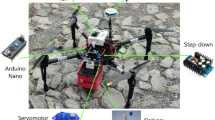Abstract
Under the assumption that sensors are distributed in the environmental side to measure human movement in a term, such as a couple of days, we first propose a human frequency map (HFM), which is a grid map based on the observed human position and frequency in the term. Then, using such an HFM and the distributed sensor data, the possibility of encountering human and the width of passage in addition to the current position of human are taken into account in our new path planning method. The usefulness of the proposed path planning approach is demonstrated through simulations in dynamic environments, as well as actual experiments to show the realization of safe robot navigation.




















Similar content being viewed by others
References
Appenzeller, G., Lee J., & Hashimoto H. (1997). Building topological maps by looking at people: An example of cooperation between intelligent spaces and robots. Proceedings of the 1997 IEEE/RSJ International Conference on Intelligent Robot and Systems, Vol. 3, ( pp. 1326–1333)
Aurenhammer, F. (1991). Voronoi diagrams: A survey of a fundamental geometric data structure. ACM Computing Surveys, 23(3), 345–405.
Barraquand, J., Langlois, B., & Latombe, J. C. (1992). Numerical potential-field techniques for robot path planning. IEEE Transactions on Systems, Man, and Cybernetics, 22(2), 224–241.
Brock, O., & Khatib, O. (2002). Elastic strips: A framework for motion generation in human environments. International Journal of Robotics Research, 21(12), 1031–1052.
Choset, H., & Nagatani, K. (2001). Topological simultaneous localization and mapping (SLAM). IEEE Transactions on Robotics and Automation, 17(2), 125–137.
Ferguson, D., Kalra, N., & Stents, A. (2006). Replanning with RRTs, robotics and automation. Proceedings of the IEEE International Conference on Robotics and Automation (ICRA), (pp. 1243–1248).
Hofner, C., & Schmidt, G. (1995). Ath planning and guidance techniques for an autonomous mobile cleaning robot. Robotics and Autonomous Systems, 14(2–3), 199–212.
Lee, J.-H., & Ando, N. (1999). Mobile robot architecture in intelligent space. Journal of Robotics and Mechatronics, The Japan Society of Mechanical Engineers, 11, 165–170.
Lozanoperez, T., & Wesley, M. A. (1979). Algorithm for planning collision-free paths among polyhedral obstacles. Communications of the ACM, 22(10), 560–570.
Maeyama, S., & Nishimoto, M. (2011). Generation of a pathway map based on observing human positions in an intelligent environment and its application to the path planning of a mobile robot. Transactions of the Society of Instrument and Control Engineers, 47(12), 631–639.
Miura, J., & Shirai, Y. (1997). Vision and motion planning for a mobile robot under uncertainty. International Journal of Robotics Research, 16(6), 806–825.
Nagatani, K., Iwai, Y., & Tanaka, Y. (2003). Sensor based navigation for car-like mobile robots based on generalized Voronoi graph. Advanced Robotics, 17(5), 385–401.
Oriolo, G., & Ulivi, G. (1998). Real-time map building and navigation for autonomous robots in unknown environments. IEEE Transactions on Systems, Man, and Cybernetics, Part B: Cybernetics, 28(3), 316–333.
Rennekamp, T., Homeier, K., & Kroger, T. (2004).Distributed sensing and prediction of obstacle motions for unknown moving obstacles. Proceedings of the IEEE/RSJ International Conference on Intelligent Robots and Systems, pp. 4833–4838.
Sasaki, T., & Hashimoto, H. (2008). Mobile robot navigation based on important points extracted from human observation. Transactions of The Society of Instrument and Control Engineers, 44(4), 368–376.
Author information
Authors and Affiliations
Corresponding author
Rights and permissions
About this article
Cite this article
Motonaka, K., Maeyama, S. & Watanabe, K. Path Planning and a Mobile Robot Navigation Method Based on a Human Frequency Map. J Control Autom Electr Syst 24, 87–96 (2013). https://doi.org/10.1007/s40313-013-0011-8
Received:
Revised:
Accepted:
Published:
Issue Date:
DOI: https://doi.org/10.1007/s40313-013-0011-8




